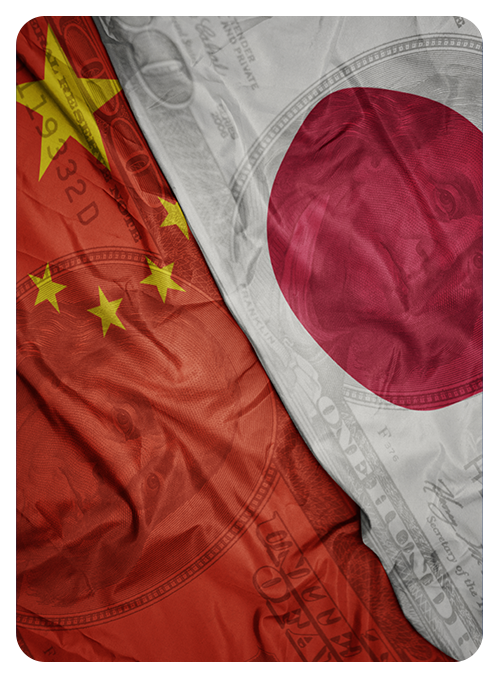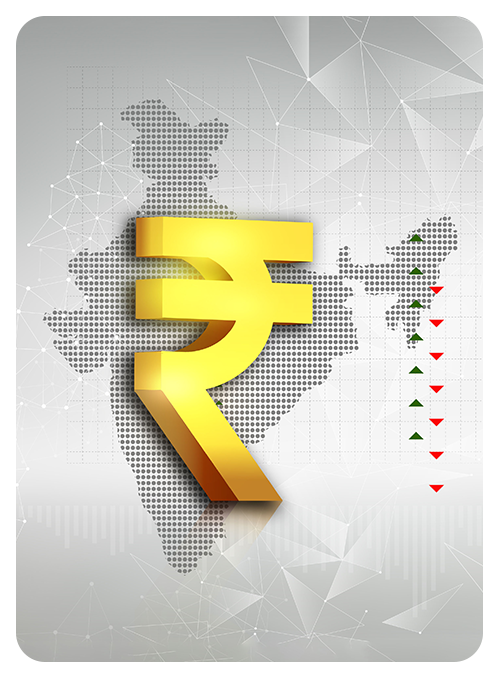Finsphere
Policy Push vs. Trade Turbulence:
Who Wins This Quarter? Find out here.

Dear Clients and Stakeholders,
Indian equity markets, which experienced a tumultuous time over the past two months, rebounded in the month of September, regaining +0.75% for the month. The headwinds from the $100,000 H1B visa fee and 100% tariff on branded or patented pharmaceutical imports from October 1, alongside 50% tariffs on cabinets, 30% on upholstered furniture, and 25% on heavy trucks, ensured volatility persisted in the market. In a bold move to stimulate domestic demand and make taxation more equitable, Central Government overhauled the GST rate structure and rolled out GST 2.0. The cuts in GST rates are expected to top up the earlier announced direct tax rate cut and interest cut against the backdrop of falling inflation and good monsoons. While the focus remains on upcoming Q2FY26 earnings, the spate of pro-growth policies has raised hopes for a strong Q3FY26 for corporate India.
President Donald Trump’s wave of tariffs continued to crash into global trade relations. The latest announcement imposed a 100% tariff on pharmaceuticals, alongside 25% tariffs on kitchen cabinets, vanities, and upholstered wooden furniture, to rise to 50% and 30% respectively from January 1. Some exceptions exist based on tariff agreements the US has reached with select trading partners such as the UK, Japan, and the European Union. Wood and furniture goods imported from the UK will face a 10% tariff, while such products from Japan and the EU will incur 15% levies. These developments have added to the uncertainty surrounding international trade.
The US government is also undergoing a federal shutdown, halting non-essential activities and placing federal employees on furlough. Unlike previous shutdowns, mass layoffs are reportedly imminent, and infrastructure funds are being curtailed in certain areas. These developments with an already cooling labour market have raised expectations for additional Fed rate cuts. Investors in US, however, have largely adopted a risk-on approach, shrugging off near-term uncertainties as S&P500 rose 3.53%, DJIA gained 1.87%, the tech heavy Nasdaq surged 5.61%, the Russell 2000 increased by 2.96% in the month of September.
As we step into the final quarter of 2025, markets find themselves at a tipping point as macro signals point to uncertainty over sustained economic growth. This newsletter unpacks these dynamics region by region—beginning with the United States, the key anchor for global risk sentiment.
United States
Investors keep a keen eye on labour market and inflationary impact of tariffs
The US economy delivered strong growth in Q3CY25, expanding at an annualized rate of 3.8%, the strongest performance since Q3CY23. The strong growth was primarily attributed to a significant uptick in consumer spending. Meanwhile, headline inflation accelerated to 2.9% YoY in August—the highest since January—after holding at 2.7% in both June and July. Core PCE, the Fed’s preferred metric, held steady at 2.9%. PPI unexpectedly fell by 0.1% month-on-month in August, the first such decline in four months. Overall, inflation data pointed to a stable inflationary scenario.
Retail sales for August grew by 0.6% month-on-month, outperforming expectations of a 0.2% gain. Similarly, industrial production rose 0.1% month-on-month, while expectations were of a 0.1% decline. Housing data remained a mixed bag. Building permits fell by 2.3%, remaining at the lowest level since May 2020; new home sales jumped by 20.5%, reaching the highest level since January 2022; and existing home sales ticked up by 0.2% month-on-month in August to 4 million units.
The Fed, in its latest FOMC meeting, acknowledged signs of moderation in economic activity in H1CY25 and retained its cautious stance amid persistent inflationary risks and elevated geopolitical uncertainty.

While labor market conditions were still described as solid, concerns about slowing absorption remained, leading to a 25bps interest rate cut to a range of 4.00–4.25%, marking the first such reduction since December 2024.
Overall, while US economic performance has remained strong, concerns over the effect of tariffs on inflation and a cooling job market continue to persist. These worries have been compounded by the US government shutdown, triggered by an impasse over the budget, with influential voices within the government claiming this to be an opportunity for a large-scale clear-out. Amid this evolving backdrop, investors are increasingly betting on a rate cut in October to help sustain the region’s economic growth momentum.

Eurozone & UK
Slightly Firmer Inflation but Mixed Activity Keeps Central Banks on Hold
Euro area consumer price inflation rose to 2.2% in September 2025, up from 2.0% over the prior three months, driven mainly by a smaller decline in energy costs. Core inflation remained stable at 2.3%, its lowest since January 2022. On the producer side, Euro area PPI fell 0.3% month-on-month in August, suggesting moderating pipeline cost pressures. Industrial production inched up 0.3% in July, led by capital goods (+1.3%) and consumer durables (+1.1%), while energy output contracted (-2.9%). Reflecting the slightly firmer headline inflation but weak producer prices and uneven industrial activity—the ECB left its key rates unchanged (deposit 2.00%, main refinancing 2.15%, marginal lending 2.40%) and projected headline inflation to average 2.1% in 2025, easing further in 2026–27. The data points to an economy balancing near-target inflation with underlying industrial fragility, justifying the ECB’s cautious pause.
In the UK, trends remained uneven. Retail sales volumes rose 0.5% month-on-month in August, following a similar gain in July. However, three-month sales were down 0.1%, while year-on-year volumes grew 0.7% versus 1.8% in July. Labour markets showed further signs of slack, with the unemployment rate at 4.7% in the three months to July—the highest since mid-2021—even as employment reached a record 34.2 million. Industrial production contracted 0.9% month-on-month in July, while GDP growth for Q2CY25 was revised up to 1.4% year-on-year from 1.2%, supported by household spending (+1.1%) and government expenditure (+2.1%).
The Bank of England maintained Bank Rate at 4% and opted to slow its quantitative tightening by trimming gilt holdings by £70bn to £488bn over the next year. Policymakers acknowledged disinflation progress but flagged upside risks, with CPI still elevated at 3.8% in August, noting subdued GDP growth, a loosening labor market, and slack in the economy.
Both the ECB and BoE remain in wait-and-watch mode amid lingering industrial weakness, soft labour conditions, and persistent price rigidity. Against this backdrop, Europe also continues to battle political unrest as France’s newly elected Prime Minister, Mr. Sebastien Lecornu, resigned less than a month in office, leaving the EU’s second largest economy in a state of political flux.
Asia
Resilient Domestic Demand in Japan While China Rebounds on Stronger Industrial Output
In Japan, economic indicators pointed to a moderation in momentum even as inflationary pressures eased. The country’s annual inflation rate softened to 2.7% in August 2025, its lowest since October 2024, while producer prices rose 2.7% year-on-year, suggesting pipeline cost stickiness. Industrial activity continued to underperform, with industrial production contracting 1.2% month-on-month, marking a second consecutive decline as weakness in autos, metals, and electronics persisted amid trade uncertainty and subdued export demand. Trade balances also remained subdued —exports slipped 0.1% year-on-year in August while imports fell 5.2%, resulting in a ¥242.5 billion trade deficit. Labour market conditions softened, with the unemployment rate rising to 2.6%. On the domestic consumption front, retail sales declined 1.1% year-on-year, the first drop since February 2022, underscoring fragile household consumption as weak wage growth continued to erode purchasing power. Despite these short-term pressures, GDP growth in Q2CY25 was revised sharply higher to 2.2% annualized.
In China, Industrial production expanded 5.2% year-on-year in August, the slowest pace in a year, with manufacturing growth easing to 5.7%. Retail sales growth moderated to 3.4%, marking the third straight month of deceleration, reflecting sluggish domestic demand.

The unemployment rate edged up to 5.3%, the highest since February, indicating labour market fragility despite stable average working hours. Trade data offered limited support—while exports rose 4.4% and imports increased 1.2%, both undershot forecasts, keeping the trade surplus elevated at USD 102.3 billion.
Price indicators reinforced the deflationary bias: CPI fell 0.4% year-on-year, the fifth decline this year and the sharpest since February, driven by a 4.3% plunge in food prices amid ample supply and weak consumption. At the producer level, PPI contracted 2.9%, extending its deflation streak to 35 months but moderating from July’s deeper decline. The People’s Bank of China maintained its accommodative stance, keeping the seven-day reverse repo rate unchanged at 1.40% while injecting CNY 487 billion in liquidity to stabilize short-term funding conditions.
The region sits at a critical juncture. While the appointment of Ms. Sanae Takaichi—viewed as favouring expansionist policies—has raised hopes of continued growth in Japan, China’s ruling Communist Party will meet in October to map out the country’s social and economic development over the next five years, as the nation seeks to maintain economic momentum while fending off trade conflicts with the West.

India’s Economic Pulse:
Resilient Growth Amid Global Turbulence
In India, economic activity remained robust as industrial production rose 4% year-on-year in August, supported by mining and utilities, although manufacturing growth remained subdued amid ongoing global trade tensions. Core infrastructure sectors posted resilient gains, with overall output rising 6.3%—a 15-month high—led by coal, steel, and cement, underscoring pockets of strength in India’s production base despite external headwinds.
Trade dynamics reflected resilience. Merchandise exports grew 6.7% in August, while imports fell sharply by 10.1%, narrowing the trade deficit to USD 26.5 billion. The decline in imports was broad-based, with notable weakness in crude oil and natural gas, partially offsetting the impact of US tariffs imposed mid-month.
Domestic consumption and demand indicators remained healthy, supported by easing unemployment, which fell to 5.1%. Inflation at the producer level was relatively stable, rising 0.52% in August.
Monetary policy remained accommodative, with the Reserve Bank of India keeping the repo rate unchanged at 5.50%, balancing the twin objectives of supporting growth while anchoring inflation expectations. Fiscal and monetary frameworks are expected to sustain the domestic expansion, with GDP growth projections for FY2025/26 revised upwards to 6.8%, while headline inflation remains well within the 2–6% target range.
Overall, India’s macroeconomic landscape reflects an optimistic trajectory. While questions over growth remain amid global uncertainties and trade pressures, underlying industrial strength, robust domestic demand, and supportive policy measures—such as the introduction of GST 2.0, direct tax rate cuts, interest rate cuts along with a pro-growth stance of the RBI and good monsoon—continue to anchor the economy. Policymakers are likely to maintain their steady approach, providing room for consumption-led growth and infrastructure investment to drive the next phase of expansion.
Conclusion
As we navigate the final quarter of 2025, global macro conditions remain shaped by volatile trade dynamics and policy shifts. The US faces structural headwinds from tariffs, a cooling labor market, and government shutdown risks, keeping markets on edge. The Eurozone and UK are balancing near-target inflation with soft industrial activity and labor market slack, while Japan and China grapple with weak domestic demand and an evolving policy setting.
In contrast, India stands out for its relative stability. Strong domestic demand, supportive fiscal and monetary policies, moderating inflation, and a favorable monsoon provide a resilient foundation for growth. As global uncertainties persist, India’s macroeconomic tailwinds and steady policy approach position the country to sustain momentum, with consumption-led growth and infrastructure investment likely driving the next phase of expansion.
At Chola Securities, we remain steadfast in our commitment to helping you navigate these complexities with clarity and foresight. As always, we aim to align your investments with evolving opportunities while ensuring resilience against emerging headwinds.
We sincerely thank you—our valued clients and investors—for your continued confidence and partnership. Together, we look forward to embracing the challenges and opportunities of the months ahead, ensuring sustained growth and success.
Warm Regards,
N Senthilkumar
President, Chola Securities
